Study Notes: Waveguides | Electromagnetics - Electronics and Communication Engineering (ECE) PDF Download
Waveguides (Single Lines)
- The term waveguide may refer to any linear structure that conveys electromagnetic waves between its end points. At frequencies more than 3 GHz losses in the transmission lines and cables become significant due to the losses that occur in the dielectric needed to support the conductor and within the conductor itself.

- In general, a waveguide consists of a hollow metallic tube of a rectangular or circular shape used to guide an electromagnetic waves by successive reflections from the inner walls of tube.
- In the waveguide, no Transverse Electromagnetic (TEM) wave/mode can exist, but Transverse Electric (TE) and Transverse Magnetic (TM) waves can exist.
- The dominant mode in a particular guide is the mode having the lowest cut-off frequency.
Types of Waveguide
The waveguides can be classified based on these shapes given below: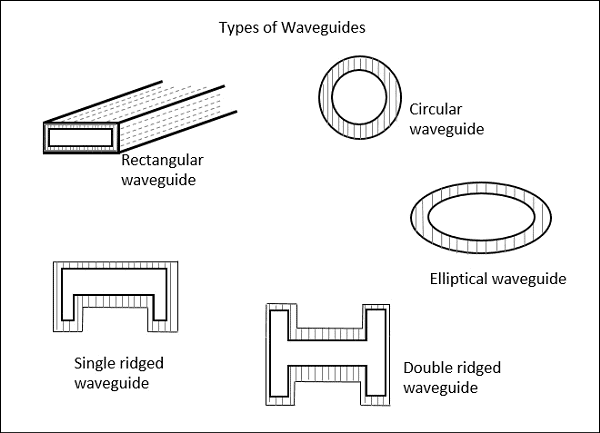
1. Rectangular Waveguide
- Rectangular waveguide is situated in the rectangular coordinate system with its breadth along x-direction, width along y-direction and z-indicates direction of propagation.
- Vector Helmholtz equations:
∇2Hz = –ω2μεHz, For TE wave (Ez = 0)
∇2Ez = –ω2μεEz, For TM wave (Hz = 0), γ = α + iβ
γ = Propagation constant, β = Phase constant, α = Attenuation constant - γ2 + ω2με = h2
 Rectangular coordinate system in Rectangular waveguide
Rectangular coordinate system in Rectangular waveguide
 (for TE wave)
(for TE wave) (for TM wave)
(for TM wave)
- Solving above equations we find Ez and Hz. Also applying Maxwell equations we can find Ex, Hx, Ey, Hy.
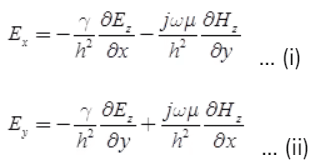

Note: For TEM wave Ez = 0 and Hz = 0, putting these values in equations (I to IV), all the field components along x and y directions, Ex, Ey, Hx, Hy vanishes and hence TEM wave cannot exist inside a waveguide.
➢ TE and TM Modes
- The electromagnetic wave inside a waveguide has an infinite number of patterns, called as modes.
- Generally two types of mode (TE and TM) are present in the waveguide. These modes are denoted as TEmn and TMmn.
m = Half wave variation along wider dimension a
n = Half wave variation along narrow dimension b
 Electric and magnetic fields in rectangular waveguide
Electric and magnetic fields in rectangular waveguide
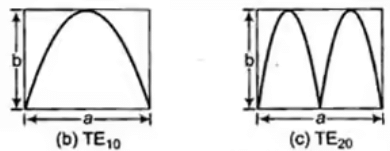 TE10 and TE20 mode in rectangular waveguide
TE10 and TE20 mode in rectangular waveguide
➢ TE Mode in Rectangular Waveguides
- TEmn modes in rectangular cavity are characterized by Ez = 0 i.e., z component of magnetic field Hz must be existing in order to have energy transmission in guide.
- TEmn field equations in rectangular waveguide as,

Ez = 0
➢ Propagation Constant
- The propagation of the wave in the guide is assumed in positive z-direction. Propagation constant γg in waveguide differs from intrinsic propagation constant γ of dielectric.

 is cut-off wave number
is cut-off wave number - For lossless dielectric γ2 = –ω2με,

➢ Cut-off Wave Number
- The cut-off wave number h is defined by

for TEmn mode there are three cases for the propagation constant γg in waveguide.
Case 1
- If ω2με = h2, then γg = 0, hence there will be no wave propagation (evanescence) in the guide.
- Thus at a given operating frequency f, only those mode having f > fc will propagate, and modes with f < fc will lead to imaginary β (or real α).
- Such modes are called evanescent modes. The cut-off frequency is

Case 2
- If ω2μ2ε > h2

Case 3
- If ω2μ2ε < h2


Note: So wave cannot propagate through waveguide as γg is a real quantity.
- For free space/ loss less dielectric (α = 0)

- The phase velocity in the positive z-direction for the TEmn

 is the phase velocity in vacuum.
is the phase velocity in vacuum.
i.e., vp = vg = c (velocity of light).
- The characteristic wave impedance of TEmn mode in the guide



- Characteristic impedance of free space is 377 Ω.

- All wavelengths greater than λc are attenuated and those less than λc are allowed to propagate through waveguide (acts as high pass filter).
➢ Guide Wavelength
- It is nothing but distance travelled by wave in order to undergo phase shift of 2π radian.

where, λg = Guide wavelength
λ0 = Free space wavelength
λc = Cut-off wavelength
when λ0 << λc ⇒ λg = λ0
when λ0 = λc ⇒ λg is infinite
at λ0 > λc, λg is imaginary i.e., no propagation in the waveguide.
➢ Phase Velocity (up)
- vp = λg ∙ f but c = f ∙ λ0
- For propagation of signal in the guide, λg > λ0, so vp is greater than velocity of light but this is contradicting as no signal travel faster than speed of light.
- However, vp represents the velocity with which a wave changes its phase in terms of guide wavelength i.e., phase velocity.

➢ Group Velocity (ug)
- If any modulated signal is transmitted through guide, then modulation envelope travels at slower speed than carrier and of course slower than speed of light.
vg = dω/dβ - For free space vp = vg and vp∙vg = c2vg =

- Te10, TE01, TE20 etc. modes can exist in rectangular waveguide but only TM11, TM12, TM21 etc. can exist.
➢ Power Transmission in Rectangular Waveguide
 for TEmn mode
for TEmn mode for TMmn mode
for TMmn mode
where a and b are the dimensions of waveguide and is intrinsic impedance of free space.
is intrinsic impedance of free space.
➢ TM Waves/Modes in Rectangular Waveguide
- For TM mode Hz = 0 i.e., the z component of electric field E must exist in order to have energy transmission in the guide.
- The TMmn mode field equations are

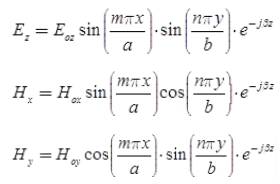
Hz = 0 - Some of the TM mode, characteristic equations are same as that of TE mode but some are different and they are given as
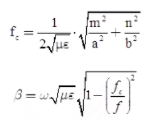


➢ Power Loss in a Waveguide
There are two ways of power losses in a waveguide as given below:
(i) Losses in the dielectric
(ii) Losses in the guide walls
- If the operational frequency is below the cut-off frequency, propagation constant y will have only the attenuation term u, i.e., β will be imaginary implying that no propagation but total wave attenuation.
- So,

but,
- So,

- So attenuation constant
 dB/length
dB/length - So this is the attenuation at f < fc but for f > fc there is very low loss.
fc = cut off frequency - Also attenuation due to non-magnetic dielectric is given by

- δ–loss tangent of the dielectric material is given as,

- The attenuation constant due to imperfect conducting walls in TE10 mode is given as

η0 = Intrinsic impedance for free space [η0 = 377Ω]
Rs = Surface resistance (Ω/m2)
but Rs = ρ/δ = 1/σδ
ρ = Resistivity
σ = Conductivity in S/m
δ = Skin depth (corresponds to skin losses)
For free space μ = μ0μr
μr = 1 and μ0 = 4π × 10–7 H/m for free space.
➢ TE Modes in Rectangular Waveguide
- TE00 mode : m = 0, n = 1 It cannot exist, as all the field components vanishes.
- TE01 mode: m = 0, n = 1 Ey = 0, Hx = 0 and ExHy exist.
- TE10 mode: m = 1, n = 0 Ex = 0, Hy = 0, Ey and Hx exist.
- TE11 mode: m = 1 and n = 1;

- For TE10 mode, λc10 = 2a
- TE01 mode, λc01 = 2b
- TE11 mode,

- Similarly for TM mode also, different modes represents different cut-off wavelength.
2. Circular Waveguide
- A circular waveguide is a tabular circular conductor. Figure shows circular waveguide of radius a and length z, placed in cylindrical coordinate systems.
- A plane wave propagating through a circular waveguide results in TE and TM modes.
- The vector Helmholtz wave equation for a TE and TM wave travelling in a z-direction in a circular waveguide is given as,
∇2Hz = 0 and ∇2Ez = 0 Circular Waveguide
Circular Waveguide
➢ TE Modes in Circular Waveguide
- Helmholtz equation of Hz in circular guide is given as
∇2Hz = γ2 ∙ Hz - TEmn modes in circular waveguide

Ez = 0
 = represent characteristic wave impedance in the guide,
= represent characteristic wave impedance in the guide,
when n = 0, 1, 2, 3 and m = 1, 2, 3, 4,….. - The first subscript n represents, number of full cycles of field variation in one revolution through 2π radian of φ, while second subscript m indicates the number of zeros of Eφ i.e., J'n(P'nmr/α along the radius of a guide.


- The phase velocity, group velocity and guide wavelength remains same as that of rectangular waveguide.
➢ TM Modes in Circular Waveguide
- The TMnm modes in a circular guide are defined as Hz = 0. But Ez ≠ 0, in order to transmit energy in the guide.
- Helmholtz equation in terms of Ez in circular guide is ∇2Ez = γ2Ez
- The field equation for TMnm modes are given as


Hz = 0
H = Pnm/α, n = 0, 1, 2, 3 and m = 1, 2, 3, 4
➢ Key Points
- For TE wave P'nm/α and Pnm/α for TM waves

- TE11 is the dominant mode in circular waveguide for TE11, P'nm = 1.841
So λc for TE11 = 2πα/1.841 also for TM wave λc = 2π/h = 2πα/Pnm
Note: TEM mode cannot exist in circular waveguide.
 (a) Circular waveguide
(a) Circular waveguide
 TE01 Mode in circular waveguide
TE01 Mode in circular waveguide
 (b) Circular waveguide
(b) Circular waveguide


➢ Power Handling Capacity
- For rectangular waveguide:(in watt)

where, Ed = Dielectric strength of material, fc = Cut off frequency for TE10 mode, f = Operating frequency, and fmax = Maximum frequency - For circular waveguide:

➢ Power Transmission in Circular Waveguide or Coaxial Lines
- For a loss less dielectric:

where, = Wave impedance in guide, a Radius of the circular guide,
= Wave impedance in guide, a Radius of the circular guide, - The average power transmitted through a circular waveguide for TEnp modes is given by

- For a TMnp modes:

|
11 videos|94 docs|89 tests
|
FAQs on Study Notes: Waveguides - Electromagnetics - Electronics and Communication Engineering (ECE)
| 1. What is a waveguide? |  |
| 2. What are the types of waveguides? |  |
| 3. How does a waveguide work? |  |
| 4. What are the advantages of using waveguides? |  |
| 5. What are the applications of waveguides? |  |





















